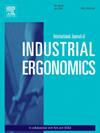Understanding the drivers of and barriers to adopting passive back- and arm-support exoskeletons in construction: Results from interviews and short-term field testing
IF 2.5
2区 工程技术
Q2 ENGINEERING, INDUSTRIAL
International Journal of Industrial Ergonomics
Pub Date : 2025-03-14
DOI:10.1016/j.ergon.2025.103732
引用次数: 0
Abstract
Construction workers experience high rates of work-related musculoskeletal disorders (WMSDs), particularly affecting the back and shoulders. Exoskeletons (EXOs), including arm-support (ASEs) and back-support (BSEs) devices, have clear potential as ergonomic interventions for reducing WMSD risks, yet the specific benefits and limitations in the construction industry remain largely unclear. We aimed to identify drivers and barriers to adopting EXOs in construction, which was done using a two-phase approach: an interview study involving 24 construction stakeholders, followed by a field study with 22 construction workers. Participants in the interview study had hands-on experiences with diverse EXOs, then provided feedback on initial impressions, perceived barriers, and potential benefits of EXO use. Interview recordings were analyzed for sentiment, systematically categorizing responses as positive, neutral, and negative. During the field study, workers wore EXOs while performing their job tasks for up to 1 h, then completed structured exit surveys that assessed usability, comfort, safety, and overall satisfaction. We found a generally positive view of EXO technology in construction, with stakeholders open to adoption for enhancing productivity and reducing physical demands. However, usability, safety, and social acceptance concerns indicated a need for design improvements focused on comfort and compatibility. Notably, safety concerns expressed by interviewees contrasted with positive field study responses, suggesting that the input obtained can vary between assessment conditions. Future research should include longitudinal studies to track shifts in perception and assess diverse designs. These findings highlight the need for refined EXOs to meet construction demands and support broader industry adoption.
了解在建筑中采用被动背部和手臂支撑外骨骼的驱动因素和障碍:来自访谈和短期现场测试的结果
建筑工人患与工作相关的肌肉骨骼疾病(WMSDs)的比例很高,尤其是背部和肩部。外骨骼(EXOs),包括臂支撑(ase)和背支撑(bse)设备,作为降低WMSD风险的人体工程学干预措施,具有明显的潜力,但在建筑行业的具体好处和局限性仍不清楚。我们的目标是确定在建筑中采用exo的驱动因素和障碍,这是通过两阶段的方法完成的:一项涉及24个建筑利益相关者的访谈研究,然后是对22个建筑工人的实地研究。访谈研究的参与者有不同EXO的亲身体验,然后就EXO的最初印象、感知到的障碍和使用EXO的潜在好处提供反馈。对访谈录音进行情绪分析,系统地将回答分为积极、中性和消极。在现场研究中,工人们穿着exo执行工作任务长达1小时,然后完成结构化的离职调查,评估可用性、舒适性、安全性和总体满意度。我们发现EXO技术在建筑中的应用总体上是积极的,利益相关者愿意采用EXO技术来提高生产力和减少物理需求。然而,可用性、安全性和社会接受度方面的考虑表明,需要在舒适性和兼容性方面进行设计改进。值得注意的是,受访者表达的安全担忧与积极的实地研究反应形成了对比,这表明所获得的输入可能因评估条件而异。未来的研究应该包括纵向研究,以跟踪感知的变化和评估不同的设计。这些发现强调了改进exo以满足施工需求并支持更广泛的行业采用的必要性。
本文章由计算机程序翻译,如有差异,请以英文原文为准。
求助全文
约1分钟内获得全文
求助全文
来源期刊
CiteScore
6.40
自引率
12.90%
发文量
110
审稿时长
56 days
期刊介绍:
The journal publishes original contributions that add to our understanding of the role of humans in today systems and the interactions thereof with various system components. The journal typically covers the following areas: industrial and occupational ergonomics, design of systems, tools and equipment, human performance measurement and modeling, human productivity, humans in technologically complex systems, and safety. The focus of the articles includes basic theoretical advances, applications, case studies, new methodologies and procedures; and empirical studies.

 求助内容:
求助内容: 应助结果提醒方式:
应助结果提醒方式:


